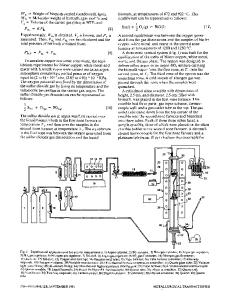Characterisation of the raw metal sources used for the production of copper and copper-based objects with copper isotope
- PDF / 766,742 Bytes
- 12 Pages / 595.276 x 790.866 pts Page_size
- 70 Downloads / 321 Views
ORIGINAL PAPER
Characterisation of the raw metal sources used for the production of copper and copper-based objects with copper isotopes Sabine Klein & Gerhard Peter Brey & Soodabeh Durali-Müller & Yann Lahaye
Received: 10 November 2008 / Accepted: 24 February 2010 / Published online: 18 March 2010 # Springer-Verlag 2010
Abstract Copper isotopes can be successfully used to determine the origin of copper or bronze artefacts from either primary or supergene sulphide or hydrocarbonate ores. In conjunction with lead isotopes, they provide information on the origin and type of the metal ore. We demonstrate this in this paper from the combination of literature and own data on metal ores and artefacts (coins and ingots). Low-temperature hydrocarbonates (esp. malachite and azurite) do not fractionate the copper isotopes amongst each other and have identical lead isotopes. Substantial fractionation of copper isotopes, however, occurs between copper sulphides and hydrocarbonates (malachite, azurite) such that the 65Cu isotope is always enriched in the oxidised relative to the sulphide phase with a clear distinction between the two ore types. Expressed in the δ65Cu notation, we assigned supergene sulphides to values less than −0.4‰ down to negative values of −2‰ and more, primary sulphides to a range between −0.4 and +0.3‰ and hydrocarbonates to positive values higher than +0.3‰. We have applied these boundaries to copper coins and ingots from the time of the Roman emperors with S. Klein (*) : G. P. Brey Institut für Geowissenschaften, Petrologie und Geochemie, J.W. Goethe Universität, Altenhöferallee 1, 60438 Frankfurt a. M., Germany e-mail: [email protected] S. Durali-Müller Research and Development XRF, Bruker AXS GmbH, Östliche Rheinbrückenstrasse 49, 76187 Karlsruhe, Germany Y. Lahaye GTK-Geological Survey of Finland, Betonimiehenuja 4, 02151 Espoo, Finland
known ages from Augustus up to 250 AD. The deposit fields of the metal used for the production of the coins were previously identified from the lead isotope ratios to lie in the Southwest and the Central South of Spain. From the combination of the lead and copper isotopes and the exact time constrains, we could develop a picture of the change in mining activities in Spain involving continued mining sulphide ore deposits and, indicated by positive δ65Cu values as proxies for malachite and azurite, the opening of new mines in various time slots. This first application shows that copper isotopes will become the most important tool in archaeometallurgy to distinguish between the exploitation of deeper-seated primary and supergene sulphide ores and shallower, secondary hydrocarbonate ores. This will become especially relevant for archaeometric questions regarding the distinction between occasional and intentionally produced alloys. Keywords Copper isotopes . Lead isotopes . Provenance . Roman . Coins . Ingots . Copper . Ores . Spain . Central Iberian zone . Iberian Pyrite Belt . Germany . Deposits
Introduction The use of lead isotope ratios to pinpo
Data Loading...











